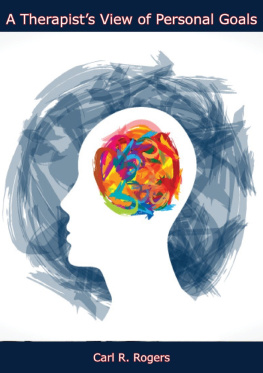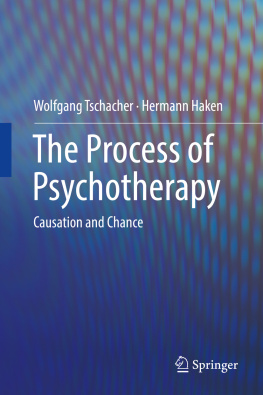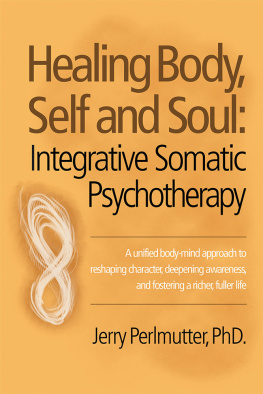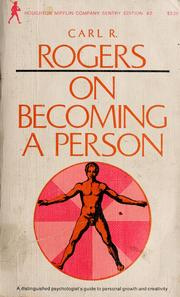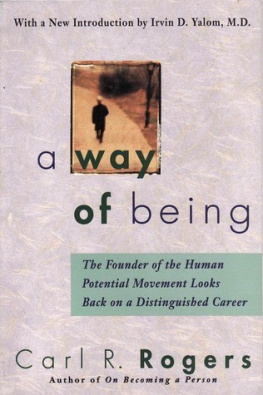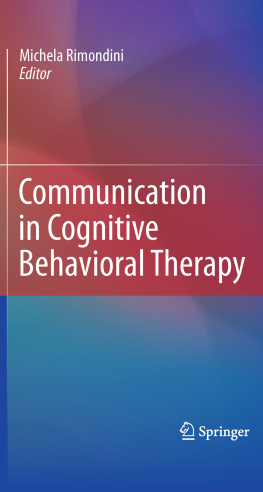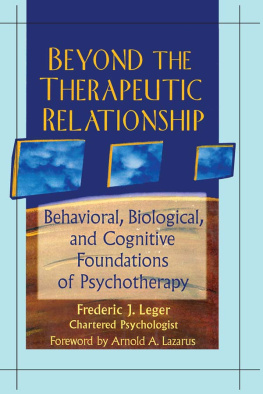Copyright 1961 by Carl R. Rogers
Copyright renewed 1989 by Carl R. Rogers
Introduction copyright 1995 by Peter D. Kramer, M.D.
All rights reserved
For information about permission to reproduce selections from this book, write to Permissions, Houghton Mifflin Harcourt Publishing Company, 215 Park Avenue South, New York, New York 10003.
www.hmhco.com
Library of Congress Cataloging-in-Publication Data is available.
ISBN : 978-0-395-75531-0
ISBN : 0-395-75531-X
e ISBN 978-0-544-08666-1
v4.0615
Introduction
T HE PUBLICATION, IN 1961, of On Becoming a Person brought Carl Rogers unexpected national recognition. A researcher and clinician, Rogers had believed he was addressing psychotherapists and only after the fact discovered that he was writing for peoplenurses, housewives, people in the business world, priests, ministers, teachers, youth. The book sold millions of copies when million was a rare number in publishing. Rogers was, for the decade that followed, the Psychologist of America, likely to be consulted by the press on any issue that concerned the mind, from creativity to self-knowledge to the national character.
Certain ideas that Rogers championed have become so widely accepted that it is difficult to recall how fresh, even revolutionary, they were in their time. Freudian psychoanalysis, the prevailing model of mind at mid-century, held that human drivessex and aggressionwere inherently selfish, constrained at a price and with difficulty by the forces of culture. Cure, in the Freudian model, came through a relationship that frustrated the patient, fostering anxiety necessary for the patient to accept the analysts difficult truths. Rogers, in contrast, believed that people need a relationship in which they are accepted. The skills the Rogerian therapist uses are empathya word that in Freuds time was largely restricted to the feelings with which an observer invests a work of artand unconditional positive regard. Rogers stated his central hypothesis in one sentence: If I can provide a certain type of relationship, the other will discover within himself the capacity to use that relationship for growth, and change and personal development will occur. By growth, Rogers meant movement in the direction of self-esteem, flexibility, respect for self and others. To Rogers, man is incorrigibly socialized in his desires. Or, as Rogers puts the matter repeatedly, when man is most fully man, he is to be trusted.
Rogers was, in Isaiah Berlins classification, a hedgehog: He knew one thing, but he knew it so well that he could make a world of it. From Rogers comes our contemporary emphasis on self-esteem and its power to mobilize a persons other strengths. Rogerss understanding of acceptance as the ultimate liberating force implies that people who are not ill can benefit from therapy and that nonprofessionals can act as therapists; the modern self-help group arises quite directly from Rogerss human potential movement. That marriage, like therapy, depends on genuineness and empathy is basic Carl Rogers. It is Rogers, much more than Benjamin Spock, who speaks for nondirective parenting and teaching.
It is ironic that while Rogerss ideas are in the ascendantso much so that they are now attacked as powerful cultural assumptions in need of revisionhis writings are in eclipse. This is a shame, because a culture should know where its beliefs originate and because Rogerss writing remains lucid, charming, and accessible.
Certainly Rogerss ideas prevail within the mental health professions. Todays cutting-edge school of psychoanalysis is called self psychology, a name Rogers could have coined. Like client-centered therapy, which Rogers developed in the 1940s, self psychology understands relationship, more than insight, to be central to change; and like client-centered psychotherapy, self psychology holds that the optimal level of frustration is as little as possible. The therapeutic posture in self psychology resembles nothing so much as unconditional positive regard. But self psychologyfounded in Chicago, when Rogers was a preeminent figure therehas given Rogers nary a word of credit.
Much of the explanation has to do with who Rogers was. American rather than European, farm-raised rather than urban (he was born in Chicago but moved to the country at age twelve and said his respect for the experimental method arose from his reading, in adolescence, of a long text called Feeds and Feeding), midwestern rather than eastern, sanguine rather than melancholic, accessible and open, Rogers displayed none of the dark complexity of the postwar intellectual. Rogerss opennessin an important sense On Becoming a Person needs no introduction, since Rogers introduces himself in an essay exactly titled This is Mestands in contrast to the posture favored by his peers, who believed the therapist must present himself as a blank slate. The prevailing judgment was that Rogers could be dismissed because he was not serious.
This judgment hides and reveals a narrow view of what is serious or intellectual. Rogers was a university professor and a widely published scholar, with sixteen books and more than two hundred articles to his credit. The very success of On Becoming a Person may have injured Rogerss academic reputation; he was known for the directness and simplicity of these essays, not for the complexity of more technical theoretical articles written in the same period. But even in On Becoming a Person, Rogers places his ideas in historical and social context, alluding to contemporary social psychology, animal ethology, and communications and general systems theory. He locates his heritage in existential philosophy, referring most often to Sren Kierkegaard (from whom he takes the phrase to be that self which one truly is, Rogerss answer to the question What is the goal of life?) and Martin Buber. And Rogers enjoyed a busy career as a public intellectual, debating and corresponding openly with such figures as Buber, Paul Tillich, Michael Polanyi, Gregory Bateson, Hans Hofman, and Rollo May.
More than most of his colleagues, Rogers was a committed scientist espousing an empirical evaluation of psychotherapy. As early as the 1940s, and before anyone else in the field, Rogers was recording psychotherapeutic sessions for the purpose of research. He is the first inventor of a psychotherapy to define his approach in operational terms, listing six necessary and sufficient conditions (engaged patient, empathic therapist, etc.) for constructive personality change. He developed reliable measures and sponsored and publicized evaluations of his hypotheses. Rogers was committed to an assessment of process: What helps people to change? His research, and that of his scientific collaborators, led to results embarrassing to the psychoanalytic establishment. For example, one study, of transcripts of therapy sessions, found that in response to clarification and interpretationthe tools of psychoanalysisclients typically abandon self-exploration; only reflection of feeling by the therapist leads directly to further exploration and new insight.
Rogers, in other words, marshaled a substantial intellectual effort in the service of a simple belief: Humans require acceptance, and given acceptance, they move toward self-actualization. The corollaries of this hypothesis were evident to Rogers and his contemporaries. The complex edifice of psychoanalysis is unnecessarytransference may well exist, but to explore it is unproductive. A haughty and distant posture, the one assumed by many psychoanalysts at mid-century, is certainly countertherapeutic. The self-awareness and human presence of the therapist is more important than the therapists technical training. And the boundary between psychotherapy and ordinary life is necessarily thin. If acceptance, empathy, and positive regard are the necessary and sufficient conditions for human growth, then they ought equally to inform teaching, friendship, and family life.
Next page






